Transcon switches to more robust
search capabilities
It would gradually replace the current content management system developed by Varennes, Que.-based Marcotte Systems Ltd. The bottom line is to generate more revenues with online advertising, said Jean-Paul Chauvet, vice-president of e-publishing at Nstein. “For Canadian Living we’re going to add our semantic capabilities to post links to more content that reaches (the readers’) interests,” said Chauvet.
(For those of you, like me, who don't know what a 'semantic capability' is, it apparently makes it easier for readers to search articles and spend more time with the sites, thereby being exposed to more buttons, banners and the like.)
The old system required staff, editors mostly, to manually input key words for searching. The new system will create automatic lists of key words in articles that will allow for better indexing within the search engines, said Yves Auger, director of operations and Web technologies at Transcontinental Inc., which also publishes ITBusiness.ca.
“Right now how it works is somebody writes an article and there is a section or field that needs to be filled with keywords,” he said. “Nstein will provide automatic keywords for each article. It will also provide automatic related articles.”
The other main reason for switching systems is to optimize the process of production. Editors currently have to copy and paste content from their print publications into the content management system.






















